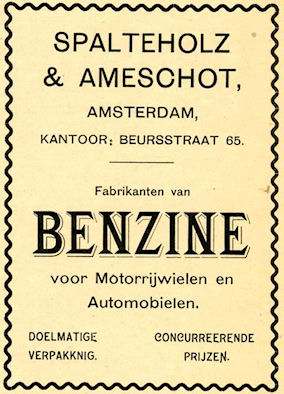


Schilperoort van Ypen & Co
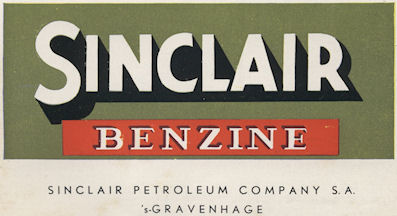
Spalteholz & Ameschot Sinclair Petroleum Comp S.A.
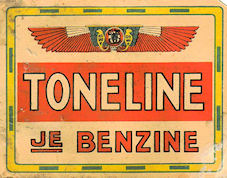
Toneline, gevestigd aan het Rokin 9-15 in Amsterdam, was een van oorsprong Franse maatschappij die in maart 1927 haar activiteiten in Nederland verkocht aan de American Petroleum Company in Den Haag

advertentie 1909
 Koninklijke Nederlandsche Petroleum
Maatschappij
Koninklijke Nederlandsche Petroleum
Maatschappij
(Royal Dutch Petroleum Company)

The Royal Dutch Petroleum Company refinery @ Rotterdam. (photo: www.rotterdammers.nl)
Brief history of Shell activities in Holland:
|
1890 |
NV Koninklijke Nederlandsche Maatschappij tot Exploitatie van Petroleumbronnen (Royal Dutch Petroleum Company) Exploring oil wells in the West Indies. Main product is paraffin for lamps, traded under “Crown Oil”. |
|
1896 |
Marcus Samual starts his own exploration at Borneo |
|
1897 |
Marcus Samual created the Shell Transport and Trading Company. |
|
1902 |
A petrol refinery was installed at the Sluisjesdijk in the Rotterdam harbour area by the Royal Dutch Petroleum Comp. Crude oil and petrol was delivered here from overseas by large tanker ships. |
|
1903 |
Start of the Asiatic Petroleum Comp Ltd as a common trading company from Shell, de Rotschild and Royal Dutch |
|
1907 |
Further amalgamation between Royal Dutch and Shell Transport and Trading Comp. Both companies stay autonomous but their assets are put into several separate operating trading companies. For Royal Dutch this became Bataafsche Petroleum Maatschappij. A sub company of Bataafsche Petroleum Maatschappij was “Acetylena”, selling petrol under the brand name “Autoline”. |
|
1925 |
Acetylena is renamed as Bataafsche Import Maatschappij. From then on the Shell logo was commonly used as trademark for all products of Royal Dutch. |
Most
oil and petrol for the Rotterdam refinery came from the colonies Dutch East Indies and British Indies, some
diesel and crude oil from North America, crude oil from Mexico.
All was refined at the Rotterdam refinery into asphalt, petrol, diesel, turpentine, cleaning petrol, and heavy fuel.
 The
well known Shell petrol was here sold under the brand name Autoline by the Shell
subsidiary Acytelena It was delivered in red 200 ltr steel
barrels and green coloured 10 litre cans.
The
well known Shell petrol was here sold under the brand name Autoline by the Shell
subsidiary Acytelena It was delivered in red 200 ltr steel
barrels and green coloured 10 litre cans.
Diesel and heavy fuel was distributed up stream in smaller vessels at a capacity of 200 tons/hour (1925)
Asphalt for road making and industrial use was made in large quantities and packed in wooden and steel barrels.
In 1936 the Shell refinery was moved to Pernis where it is still located in 2006, now being the biggest refinery of Europe.
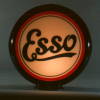
APC, Esso Holland
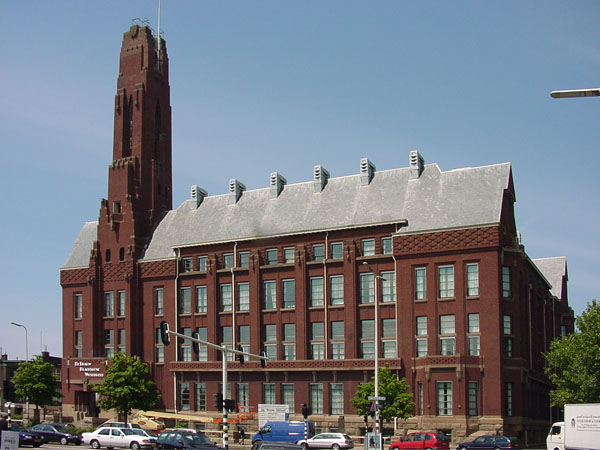
In March 1891 the "American Petroleum Company" (APC) was formed by Sturtsberg & Co, Speth & Co, Graf & Maquinay, and Horstmann & Co bringing together some Petroleum import and selling companies from Belgium and Holland. Two offices were created in Rotterdam and Antwerp.The shares of APC were partly owned by the American Standard Oil Company but they did not have a majority.
Rotterdam became the head office occupying the old offices from Horstmann & Co at the Willemskade.
Starting off with the all important parrafine trade they started importing petrol from 1906. From 1924 the Dutch Esso head office was based in The Hague, called "Petrolea".
The American idea of pedlars was also introduced in the Netherlands by the APC trading company “De Automaat”. Through the pedlar system thousands of people worked direct or indirectly for APC. A large network consisting of head depots, depots and sub depots was created. A huge fleet of horse drawn carts, dogcarts and man pushed carts transported the several fuels to your doorstep.
One of their strong points was the issueing of a weekly magazine for children called "Automaat" about the adventures of "Pijpje Drop" a little black boy.
Some examples of the magazine on the left.
A later magazine told stories about a young man called: "Peter Olie" who went through all sort of adventures.
APC managed a market share of 80 %, making it quite likely that all our grand and grand grand parents were relying on APC for heating, lightning and later motorised transport.
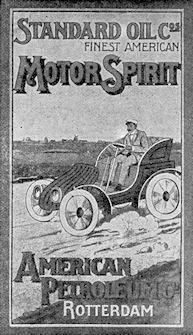 When the first motorcars appeared on our roads at
the beginning of the 20th century the distribution of petrol carrying
the brand name "Motorspirit" was by
the existing mainly paraffin selling network.
When the first motorcars appeared on our roads at
the beginning of the 20th century the distribution of petrol carrying
the brand name "Motorspirit" was by
the existing mainly paraffin selling network.
The first consumers of petrol were supplied by 200 litre barrels or crates, each containing 6 ten litre cans.
When the first garages appeared they gradually took over the supply of petrol, leaving the paraffin distribution to the older pedlar network. Fuelcans at depots were useally stored in special fireproof safe's as in the photo on the right.
The first motor fuel tanker for APC, supplying garages, came into service in 1919.
See dates for ESSO in Holland.
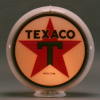
TEXACO, Continental Petroleum Comp.
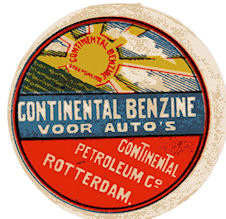
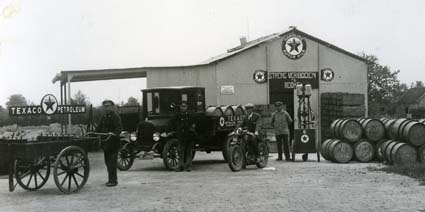 Despite
the fact that the Petrol market in Holland was already completely ruled by Shell
(Autoline) and Esso (Motorspirit, Automaat, Standard) a new supplier emerges in
the spring of 1921. Texaco which sells already kerosene here from 1911 starts
selling petrol as well. From a Texaco report of 1929 it seems that even then the
less profitable areas are still being supplied with canned petrol. Several
depots are then still equipped with petrol can filling machines.
Despite
the fact that the Petrol market in Holland was already completely ruled by Shell
(Autoline) and Esso (Motorspirit, Automaat, Standard) a new supplier emerges in
the spring of 1921. Texaco which sells already kerosene here from 1911 starts
selling petrol as well. From a Texaco report of 1929 it seems that even then the
less profitable areas are still being supplied with canned petrol. Several
depots are then still equipped with petrol can filling machines.
Kerbside petrol pumps with an underground storage tank are in 1929 still regarded as fairly new invention although everybody admits that its much more comfortable then carrying full petrol cans.